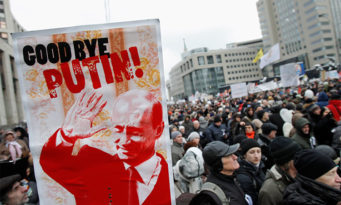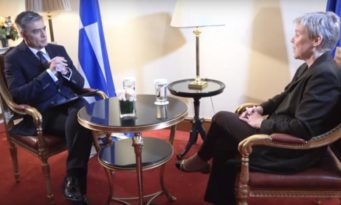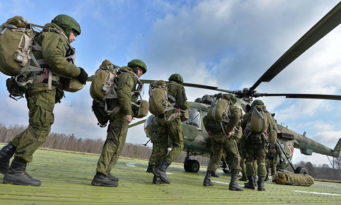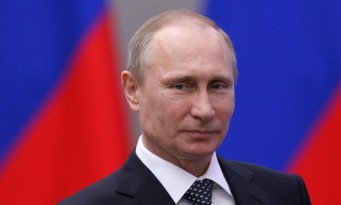Yugoslavia: Milosevic and Nationalism as a Political Weapon
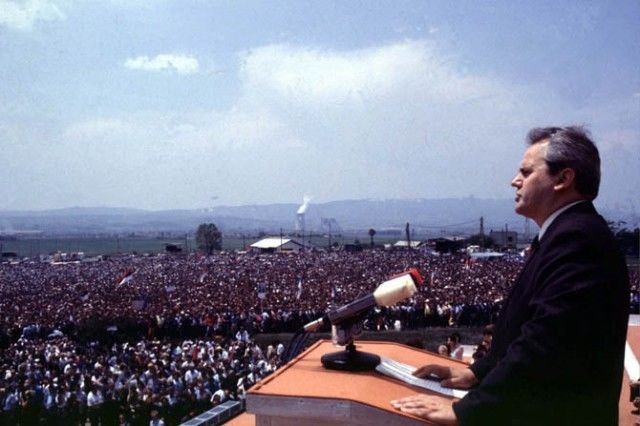
- By manuel stanescu
An important moment in the development of the future conflict in Yugoslavia was the ascent of Slobodan Milosevic, leader of the communist party since 1986 and of Serbia since 1989.
Having looked at the creation of Yugoslavia in the first part of this special feature article on Yugoslavia, now we delve into the 90's. A time when Yugoslavia was largely made up of ethnicities and denominations and when nationalism was used as a lethal weapon with tragic consequences. The protagonist during this turbulent time was Slobodan Milosevic, leader of the communist party since 1986 and of Serbia since 1989. This was also NATO's first military intervention since its creation in 1949.
In 1991 Yugoslavia was still a conglomerate of ethnicities and denominations. Except for Bosnia-Herzegovina, which was comprised of three large groups, other significant minorities were the Serbians in Croatia, at an 11% share of the population; in Montenegro 13.8% of the population was of Muslim faith. Another area dominated by minorities was Kosovo, with its Albanian population. Of the just over 23 million inhabitants of Yugoslavia, in 1991, 35.3% were Serbians, 19.2% were Croatians, 10.2% were Muslim, 9.4% were Albanians, 7.5% Slovenian, 6.1% Macedonian, 2.6% Montenegrin, to which other populations, in lower percentages, could be counted, that were spread across all provinces.
An important moment in the development of the future conflict was the ascent of Slobodan Milosevic, leader of the communist party since 1986 and of Serbia since 1989. Milosevic became aware of the efficiency of using nationalism as a political weapon. He thus brought back centralised control in the Kosovo region and fuelled Serbian nationalism in general, in order to create connections between ethnic Serbians from the various republics of the federation. Except for Montenegro, where half the population thought of itself as Serbian, the centralisation attempts from Belgrade triggered, naturally, countering reactions from the various ethnic groups, encouraged by the fall of communism in Eastern Europe and by the appearance of the multi-party system and of free elections.
Free elections were held in 1990 in Slovenia, Croatia, Macedonia, Serbia, and Bosnia-Herzegovina; those politicians that used a nationalistic rhetoric came out on top, though the nationalist character varied considerably from one republic to the other. Yet even in the most economically developed and independent regions, Croatia and Slovenia, there was no open talk of seceding. Without a doubt, the new regimes in the republics rejected the old feudal structures, being interested in a radical transformation of Yugoslavia into a confederation of sovereign states. Secession became an option when discussions among republics seemed to not lead to a result. In December 1990, the Slovenian parliament declared that, should a solution not be found within six months for the confederation problem, it would unilaterally proclaim its independence, statement echoed by a similar one from Tudjman, the Croatian president.
The toughest problem of the negotiations between republics was “the Serbian problem”, which concerned the 25% Yugoslav Serbians that lived outside the borders of Serbia. Milosevic wished for a new federative model, in which the dispersed Serbian population would be united in a single republic, the Serbians obtaining a political influence proportional to their status as the most numerous minority in Yugoslavia, perspective supported by the main leaders of the Yugoslav People’s Army - a majority of which were Serbians and Montenegrins - which saw themselves as the last bastion of the unity of the state and who saw the nationalist forces in Croatia and Slovenia as the main enemy of the notion of a Yugoslavia.
During the first few months of 1991, numerous talks took place between the leaders of the six republics and the two autonomous regions, without a result being reached in a manner that would satisfy the opposing interests of the Serbians, Croatians, and Slovenians. Except for Macedonia and Bosnia-Herzegovina, the leaders of the other regions showed no flexibility. If the Bosnian president, Izetbegovic, claimed that the survival of Yugoslavia was essential for Bosnia’s existence, Slovenia was invariably the spearhead concerning secession, position that also encouraged Croatia’s own strivings. However, Tudjman ignored the fundamental differences between the Slovenian and Croatian independence. Slovenia had a relatively homogeneous population from an ethnic point of view, with only 2% being Serbians, while Serbians represented 11% of Croatia’s population. Between 1990-1991, the Croatian regime tried to gain the upper hand in the Krajina province, with a Serbian majority population, including by creating special military units and by eliminating minorities from public administration, which fuelled the population’s fears concerning a potential comeback of the ethnic cleansing policies of the Ustashas. Tudjman’s lack of an absolute denouncement of the Croatian fascist regime of the Second World War offered Milosevic the pretext to encourage the Serbian minority to pick-up arms in order to protect itself.
The Path to War
On June 25th, 1991, Slovenia and Croatia both unilaterally declared their independence, in spite of the warnings received from the European Community and the United States that their independence will not be recognised. Within 24 hours, the Yugoslav People's Army and the Territorial Defence Force of Slovenia were ready to fight, while the Serbian paramilitary forces in Croatia had already launched their first offensive. The Slovenian conflict did not last long, the Yugoslavian army failing to reach its goals of controlling the border crossings. While the Slovenian forces were prepared, the national army had been surprised by the events. On the other hand, Milosevic had accepted Slovenia’s secession a few months before, the Yugoslavian forces lining the internal borders being quite limited in numbers. On July 7th, 1991, hostilities ceased, and by the 19th of July the troops of the Yugoslav army had withdrawn from Slovenia.
The war with Croatia was totally different in intensity and operations. In just six months, between July and December 1991, the number of victims had reached 10.000. The Yugoslavian army worked closely with the Serbian paramilitary forces in Croatia with the aim of creating a Serbian englave “cleaned” of Croatians. After two months of sporadic confrontations along the border, the war intensified as of September, when the siege by the Serbian forces of Vukovar started, the fighting lasting for three months, until the fall of the city in November. At the same time, the siege of the historic city of Dubrovnik made the news headlines around the world. The atrocities were numerous on both sides; in an ethnic cleansing unseen since World War Two, between 100.000 and 200.000 Serbians were forced to abandon their homes. The hostilities accelerated the transformation of the Yugoslav People's Army in a military force composed almost exclusively of Serbians.
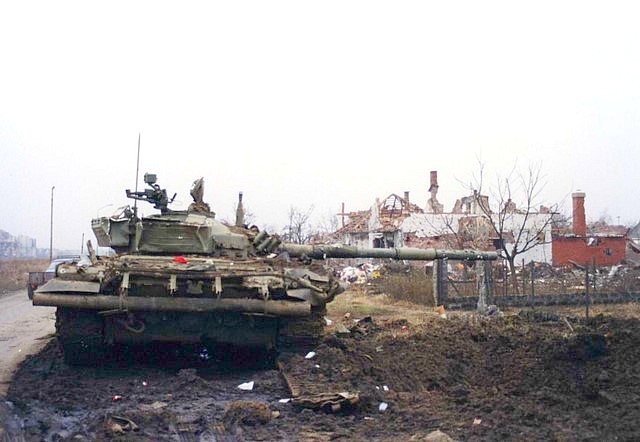
A JNA M-84 tank disabled by a mine laid by Croat soldiers in Vukovar in November 1991.
In October 1991, Lord Carrington, a veteran of British conservatism, presented a plan to move away from the crisis. Five of the six republics accepted the proposal; Milosevic refused and, as a consequence, in April 1992, Serbia and Montenegro formed the Yugoslav Federative Republic.
Pressured by Germany, on January 15th, 1992, the European Union recognised Croatia’s independence, which practically guaranteed the start of the conflict in Bosnia-Herzegovina as well, that had to choose between remaining part of Yugoslavia, which meant that the Muslims and Croatians would remain under Serbian domination, or to proclaim its independence, which would have meant the removal from Yugoslavia, against their will, of 1.3 million Serbians. Naturally, Croatia was firmly opposed to the first option, and Serbia could not accept the second. Under the false impression that Western powers would be able to guarantee the sovereignty of Bosnia-Herzegovina, president Izetbegovic made the first step towards independence, organising a referendum the 29th of January, boycotted by the Bosnian Serbian ethnics, who militated for a new Serbian-Bosnian state, the Republika Srpska. He wasn’t the first leader to get it wrong; either way, Serbia now had a pretext to attack.
From the total Bosnian population, 41% were Muslims, 31% Serbians, 18% Croatians; the Serbian and Croatian paramilitary forces were very active and had been preparing for the conflict for a long time. The conflict expanded in April 1992, when Sarajevo became a besieged city. It was the longest siege in modern history: April 5th, 1992 - February 29th, 1996. In July 1992, the Serbians were controlling 70% of Bosnia’s territory.
In January 1993, the international community proposed a 10-point plan, known as the Vance-Owen Plan, by which Bosnia was to be divided into 10 cantons, a mixture of ethnicities and religions by which the formation of three ethnic and denominational spheres of influence could be avoided. The Croat Bosnians accepted; the Bosnian authorities, although initially not very enthusiastic, eventually agreed with the peace proposal. The Serb Bosnians, however, rejected in the plan in May 1993, on the one hand fearing a Croat-Muslim control over the central authorities in Bosnia, on the other considering that the military superiority they enjoy made settling unnecessary. On top of that, the Vance-Owen plan mandated renouncing the corridor from Northern Bosnia, which connected Serbia to its areas of influence, corridor that the Serb Bosnians in particular did not want to let go.
In April 1993 intense battles erupted in the centre of the province between Croats and Muslims. Although they had been allies up to that point, the Croat Bosnians were anticipating the implementation of the Vance-Owen Plan and had moved against the Muslim forces in Herzegovina. The city of Mostar was practically destroyed during combat operations, with atrocities perpetrated by both sides, which received little international media attention, contrary to those perpetrated by the Serbians.
NATO’s involvement in the conflict in Bosnia
By the middle of the year 1993, the economic sanctions imposed on Serbia and Montenegro by the Security Council starting July 1st, 1992 started bearing fruits. For Milosevic, the priority shifted from controlling territories to lifting the sanctions. In February 1994, a mortar shell exploded in a crowded market in Sarajevo, which had a powerful impact on the public opinion. NATO addressed an ultimatum to the Serbian forces, the Alliance being prepared to launch air strikes should it not be met. Russia took advantage from the situation and its relations with Serbia by proposing to replace the Serbian forces in the exclusion zone with peacekeeping troops.
An important American initiative was aimed at the cessation of hostilities between Croats and Muslims. In March 1994, with the help of the influence Germany held with the Croatian regime, a new political entity was etched-out, the Croat-Muslim Federation. A mediation group was formed, composed of diplomats from the United States, Russia, France, Great Britain and Germany, that proposed another peace plan in July 1994. According to this new plan, 51% of the Bosnian territory went to the new Croat-Muslim Federation and 49% to the Bosniak Serbs, this at a time when, as previously mentioned, the Serb Bosnians controlled 70% of the territory. The leaders of the Serb Bosnians were warned that the sanctions already imposed against its main ally, Serbia, would be toughened. The Bosnian government, although having initially criticised the percentage of territory allocated to the Serbs, was pressed to accept the terms. Belgrade too agreed, but the Serb Bosniaks rejected it, a decision characterised by Milosevic as “pointless and absurd”, a proof of the deterioration of relations between the Serbian president and the leader of the Serb Bosniaks, doctor Radovan Karadzic.
Meanwhile, the hostilities evolved in favour of the anti-Serb forces. The help received by the Muslims from Iran and the Gulf states, the secret arming of the Croat forces by the American administration, they all shifted the balance on the battle field, as the Serbs disposed of superior numbers and equipment. Differences of opinion existed between the Western allies: the United States perceived the conflict through the lens of a Serb aggression, against which they suggested using NATO forces, preferably by means of aerial strikes, and a peace accord would invariably have to contain reduced Serb claims; the great European powers had a much wider view of the war, which was considered a civilian conflict with deep historical roots, the solution being to bringing everyone to the same perspectives.
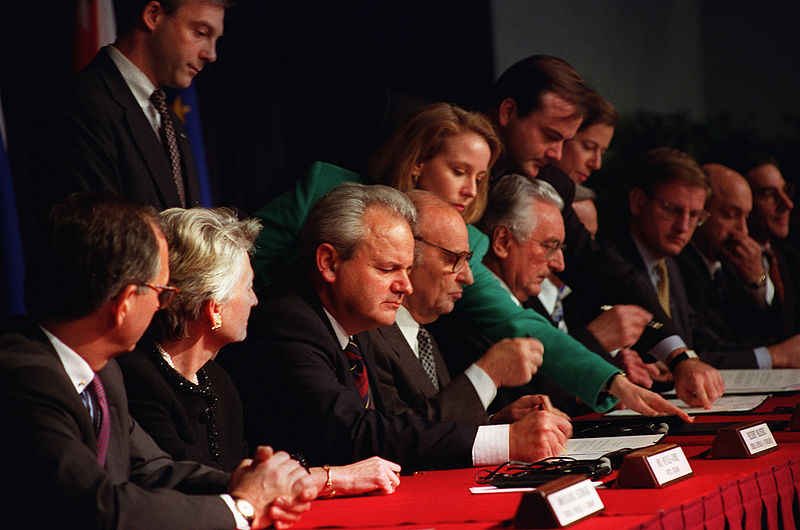
President Slobodan Milosevic of the Federal Republic of Yugoslavia, President Alija Izetbegovic of the Republic of Bosnia and Herzegovina, and President Franjo Tudjman of the Republic of Croatia initial the Dayton Peace Accords. The Balkan Proximity Peace Talks were conducted at Wright-Patterson Air Force Base Nov. 1-21, 1995. The talks ended the conflict arising from the breakup of the Republic of Yugoslavia. The Dayton Accords paved the way for the signing of the final “General Framework Agreement for Peace in Bosnia and Herzegovina” on Dec. 14 at the Elysee Palace in Paris.
During the summer of 1995, the Serb forces besieged the Muslim enclaves of Srebrenica, Zepa and Bihac. On the 28th of July, 10.000 Croat troops attacked the military units besieging Bihac. On the 4th of August, the Croats launched another attack in the Krajina region, which led to an exodus of about 200.000 Serb Bosnians; in just three days, the Croats conquered the region held by the Serbs since 1991. The Croat and Bosnian forces then started moving towards the centre of Herzegovina.
Mindful of the presidential elections of 1996, Clinton was determined to impose his point of view vis-à-vis the European allies and to speed up the end of the war. On August 29th, 1995, after Serb bombs killed 38 civilians in Sarajevo, European leaders gave in and for the first time, NATO launched an ample aerial attack, of over 60 planes, against some targets of the Serb Bosnians. On September 8th, Bosnia, Croatia, and Serbia accepted the American proposals for a cease fire. On September 26th, in New York, the belligerent parties agreed upon the concept of Bosnia – a state with a federal constitution, accepting constitutional principles such as a presidency, parliament, constitutional court and free elections. On October 5th, a cease fire was agreed upon; it entered into force the 12th October 1996. The war ended with the Dayton Accord; the final version was signed in Paris, the 14th December 1995. Estimates of the losses vary; recent sources suggest approximately 100.000 deaths. The Yugoslavian problem, however, remained unsettled and was to know a new escalation of the conflict, this time in the Kosovo region.
NATO missions in former Yugoslavia 1992-1999
The first military intervention of NATO since its creation in 1949 took place 46 years later, in August 1995, as part of Operation Deliberate Force, an aerial operation run cooperatively with the UN’s Protection Force troops against the military assets of the Bosnian-Serbs army, which threatened the so called “safe areas” created by the UN during the war in Bosnia. The mission took place between August 30th and September 20th 1995, deploying 400 aircraft and 5000 troops from 15 nations. Under the command of Admiral Leighton Smith, the mission was aimed at 338 Bosnian-Serbs’ targets, which were hit by 1026 bombs, but with minimal material losses. The Bosnian-Serbs succeeded in shooting down a Mirage 2000D aircraft on 30 August 1995, the two pilots, Lieutenant Jose Souvignet and Captain Frederic Chiffot, being freed in December, after the signing of the Dayton Peace Accords.
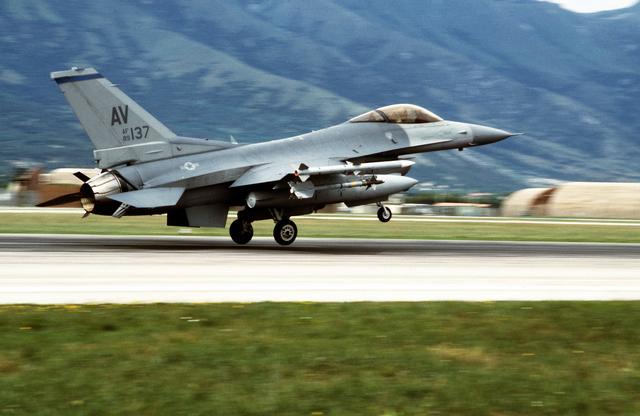
A US Air Force F-16C aircraft returns to Aviano AB, Italy, from a mission in support of NATO airstrikes against the Army of the Republika Srpska
Four years later, the 24th of March 1999, with the escalation of ethnic conflict in the Kosovo province, NATO initiated air strikes on Yugoslavia, targeting the Serbian military assets in the province. Found at the heart of the medieval kingdom of Serbia, Kosovo was conquered by the Ottoman Turks in 1389, after having defeated Serbia in the battle of Kosovo Polje. In 1913, when Kosovo was given back to Serbia, the Albanian ethnics had become the majority population, and under Tito’s rule, starting with 1974, the region benefited from an extended autonomy. Slobodan Milosevic’s policy of limiting this autonomy led to an escalation of inter-ethnic conflicts, particularly between the Kosovo Liberation Army and the Serbian police, which in 1999 turned into open conflict. On March 18th, 1999, the peace negotiations in Paris failed, after the Serbian delegation refused to sign an accord by which it would have had to recognise the autonomy of the Kosovo region and the use of NATO troops to maintain the accord. Two days later, the Serbian army initiated a large scale offensive in the region, and on 24th of March NATO was starting its air bombing campaign.
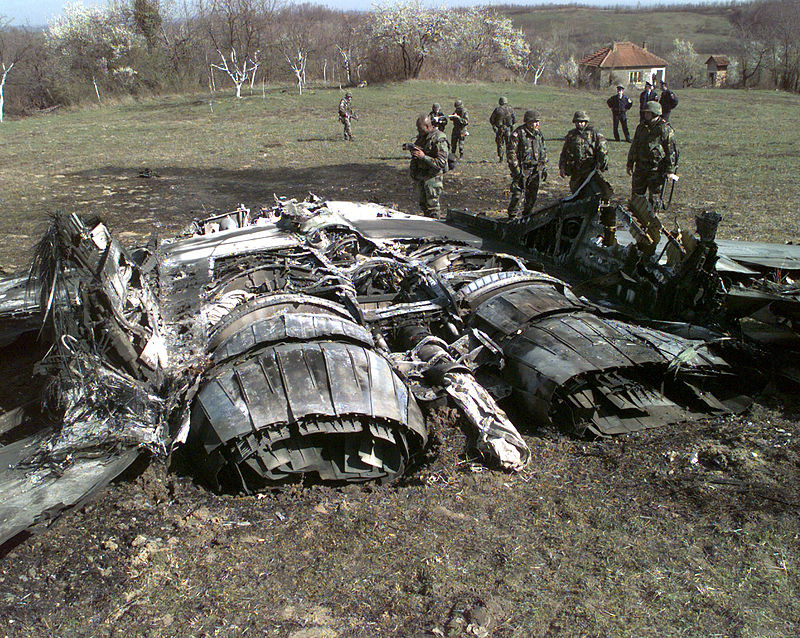
Wreckage of downed Yugoslav MiG-29 in Ugljevik on March 25, 1999.
Besides the military positions of the Serbian army, the air campaign targeted government buildings and infrastructure, in order to destabilise Milosevic’s regime. Air operations were suspended on 11 September 1999, when Serbia accepted a peace accord witch entailed the withdrawal of the Serbian forces from the province and their replacement with NATO peace keeping forces. Except for two American pilots deceased during a training mission in Albania, there were no others losses of human life during the 78 days of the operation. There were some unfortunate incidents that led to the deaths of some Albanian refugees, members of the Kosovo Liberation Army and of some Albanian civilians. The most controversial incident was the bombing of the Chinese embassy in Belgrade, on May 7th, 1999, which led to the death of three Chinese journalists and triggered a crisis in Chinese-American bilateral relations.
Milosevic was ousted from power in October 2000 and he died on 11 March 2006 in a Dutch prison, shortly prior to the conclusion of his trial in which he was accused of crimes against humanity.
At the NATO summit in Madrid of July 1997, during which the Czech Republic, Hungary and Poland received the invitation to join the Alliance, the final communique confirmed the continuation of the enlargement process, the text nominating Romania specifically among candidate states. In October 1998, the Romanian Parliament approved NATO’s request that Alliance aircraft use the country’s air space for military operations against Yugoslavia – only in exceptional and emergency cases; on 18 April 1999, NATO requested that Romanian airspace be open to its aircraft. On the 20th of April, the National Supreme Defence Council and the Romanian Government assented to this request, on the 22nd of April the Parliament following suit, authorising the use of the air space.
The support granted to the Alliance represented a significant moment in the evolution of relations between NATO and Romania; between 23-25 April 1999 the NATO summit in Washington took place, during which a Membership Action Plan was presented, that laid the base for a training and individual evaluation mechanisms for candidate countries, one of Romania's important steps on its way to join the Alliance.
Bibliography:
David Anderson, The Collapse of Yugoslavia: Background and Summary, Research Paper no. 14, 1995-1996.
The implications of the Yugoslav crisis for Western Europe´s Foreign Relations, Chaillot Papers, no. 17 – October 1994.
Florian Bieber, The Conflict in former Yugoslavia as a “Fault Line War”?, Balkanologie (Revue d´études pluridisiplinaires), vol. III, no. 1, July 1999.








